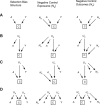Brief Report: Negative Controls to Detect Selection Bias and Measurement Bias in Epidemiologic Studies
- PMID: 27182642
- PMCID: PMC4969055
- DOI: 10.1097/EDE.0000000000000504
Brief Report: Negative Controls to Detect Selection Bias and Measurement Bias in Epidemiologic Studies
Abstract
Biomedical laboratory experiments routinely use negative controls to identify possible sources of bias, but epidemiologic studies have infrequently used this type of control in their design or measurement approach. Recently, epidemiologists proposed the routine use of negative controls in observational studies and defined the structure of negative controls to detect bias due to unmeasured confounding. We extend this previous study and define the structure of negative controls to detect selection bias and measurement bias in both observational studies and randomized trials. We illustrate the strengths and limitations of negative controls in this context using examples from the epidemiologic literature. Given their demonstrated utility and broad generalizability, the routine use of prespecified negative controls will strengthen the evidence from epidemiologic studies.
Conflict of interest statement
This study was funded in part by National Institutes of Health Grants 1R01HD078912, 1R21HD076216, 1R03HD076066, and 1K01AI119180.
The authors report no conflicts of interest.
Figures


Similar articles
-
Using fathers as a negative control exposure: Implications of measurement bias.Scand J Public Health. 2020 Aug;48(6):674-675. doi: 10.1177/1403494819850895. Epub 2019 Jul 10. Scand J Public Health. 2020. PMID: 31291829
-
[On 'Negative control methods': related principles, methods and applications].Zhonghua Liu Xing Bing Xue Za Zhi. 2020 Apr 10;41(4):594-598. doi: 10.3760/cma.j.cn112338-20191109-00796. Zhonghua Liu Xing Bing Xue Za Zhi. 2020. PMID: 32344488 Chinese.
-
Bounding formulas for selection bias.Am J Epidemiol. 2015 Nov 15;182(10):868-72. doi: 10.1093/aje/kwv130. Epub 2015 Oct 29. Am J Epidemiol. 2015. PMID: 26519426
-
Advances in methodologies of negative controls: a scoping review.J Clin Epidemiol. 2024 Feb;166:111228. doi: 10.1016/j.jclinepi.2023.111228. Epub 2023 Nov 30. J Clin Epidemiol. 2024. PMID: 38040387
-
The design of empirical studies: towards a unified view.Eur J Epidemiol. 2016 Mar;31(3):217-28. doi: 10.1007/s10654-016-0135-9. Epub 2016 Mar 11. Eur J Epidemiol. 2016. PMID: 26968840 Review.
Cited by
-
A Stepped Wedge Cluster-Randomized Trial Assessing the Impact of a Riverbank Filtration Intervention to Improve Access to Safe Water on Health in Rural India.Am J Trop Med Hyg. 2020 Mar;102(3):497-506. doi: 10.4269/ajtmh.19-0260. Am J Trop Med Hyg. 2020. PMID: 31264565 Free PMC article. Clinical Trial.
-
Statin use and lung cancer risk in chronic obstructive pulmonary disease patients: a population-based cohort study.Respir Res. 2020 May 19;21(1):118. doi: 10.1186/s12931-020-01344-w. Respir Res. 2020. PMID: 32429927 Free PMC article.
-
City-wide school-located influenza vaccination: A retrospective cohort study.Vaccine. 2021 Oct 8;39(42):6302-6307. doi: 10.1016/j.vaccine.2021.08.099. Epub 2021 Sep 14. Vaccine. 2021. PMID: 34535312 Free PMC article.
-
Target trial emulation to assess real-world efficacy in the Epidemiological Strategy and Medical Economics metastatic breast cancer cohort.J Natl Cancer Inst. 2023 Aug 8;115(8):971-980. doi: 10.1093/jnci/djad092. J Natl Cancer Inst. 2023. PMID: 37220893 Free PMC article. Clinical Trial.
-
Cardiovascular risk profile in individuals initiating treatment for overactive bladder - Challenges and learnings for comparative analysis using linked claims and electronic medical record databases.PLoS One. 2018 Oct 16;13(10):e0205640. doi: 10.1371/journal.pone.0205640. eCollection 2018. PLoS One. 2018. PMID: 30325968 Free PMC article.
References
Publication types
MeSH terms
Grants and funding
LinkOut - more resources
Full Text Sources
Other Literature Sources

